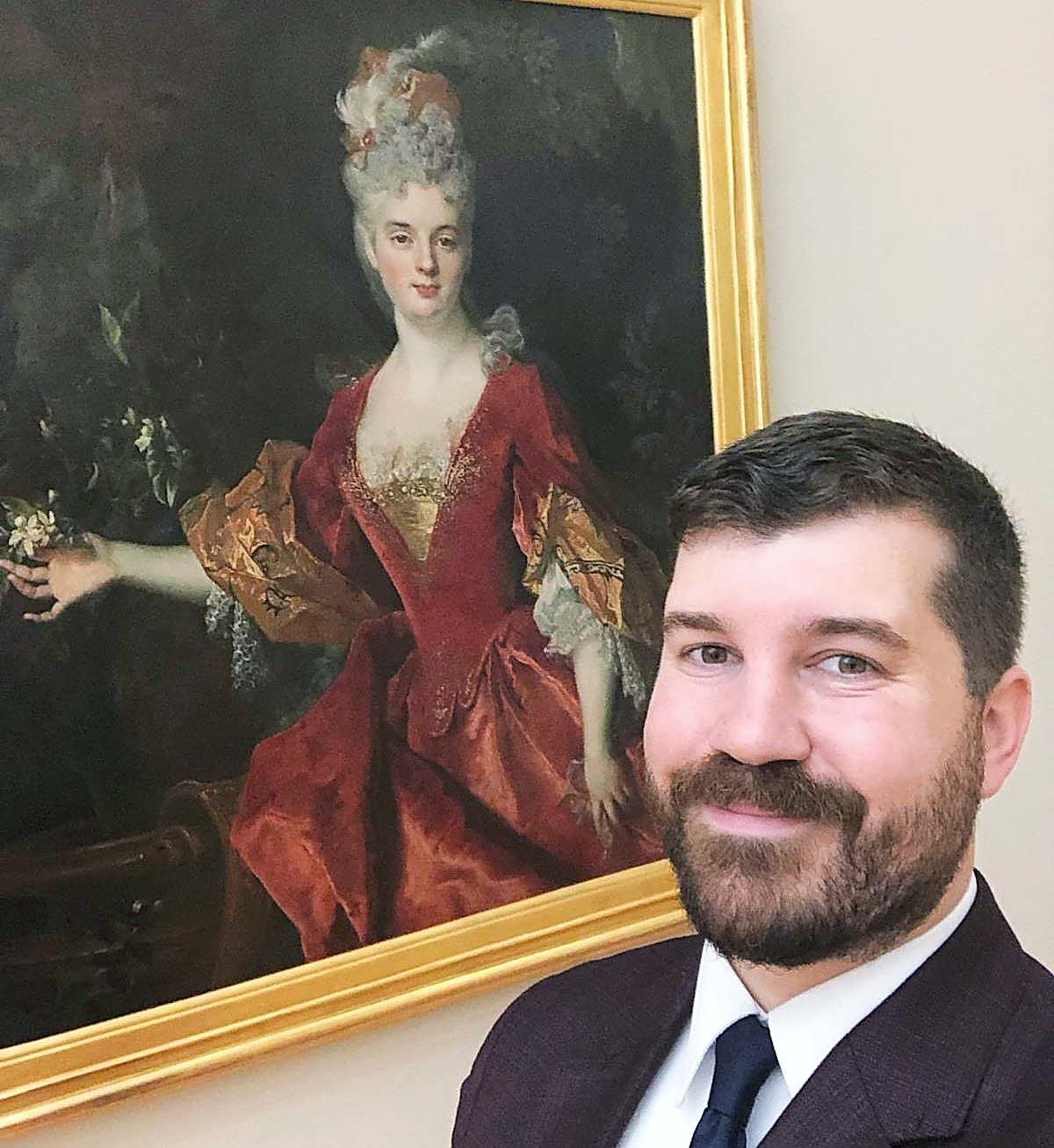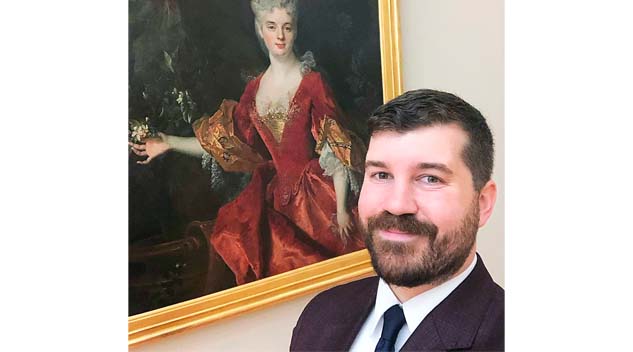#Philippe #Halbert #Antiques #Arts #Weekly

After serving as the interim curator of American Decorative Arts since November 2022, Philippe Halbert, PhD, has been named the Richard Koopman Associate Curator of American Decorative Arts at the Wadsworth Atheneum Museum of Art in Hartford, Conn. To celebrate this new role, Antiques and The Arts Weekly took time to chat with Halbert to learn how he got here and what he hopes to achieve in the position.
What inspired you to pursue a career in the arts?
My parents and grandparents took me to antique shops and museums at a very early age, and it was ancient Egyptian art that first caught my eye and imagination. Especially fascinating to me were the Fayum mummy portraits, which feature realistic depictions of the deceased painted atop wooden boards using hot wax or encaustic as well as tempera. These portraits represent a cultural synthesis of Egyptian funerary traditions and classical panel painting, resulting in sensitive likenesses of men, women and children from Roman Egypt that are strikingly modern in appearance. My historical interests kept moving forward in time, and I eventually found my “home” in the early modern period. That said, I love portraiture no matter the era, and find the idea of a “face-to-face” encounter with people of the past thrilling. That same prospect of finding a human connection brought me to material culture and decorative arts.
What is your primary function in this role?
As a curator, my work is more generally focused on collections care and interpretation. This covers research and exhibition development, identifying potential acquisitions, and addressing conservation needs. With respect to my position specifically, I oversee the Wadsworth’s American decorative arts holdings, which include more than 3,000 pieces of furniture, ceramics, glass and metalwork spanning the Seventeenth Century to the present; Mesoamerican and Andean ceramics and sculpture also fall to me. Museum work really is teamwork, and I share responsibility for a large collection of Native American baskets and beadwork with Ned Lazaro, our associate curator of Costume and Textiles. I am also the curatorial lead for Austin House, home of legendary Wadsworth director Arthur Everett “Chick” Austin, Jr (1900-1957) and his wife Helen Goodwin (1898-1986). Built in 1930 and located in Hartford’s West End, the Austin House is where baroque meets Bauhaus. We just reopened the site to the public this past July, with tours offered on the third Thursday of each month at 11 am.

Halbert recently enjoyed experimenting with this recent case installation. “Spilling the Tea” introduces visitors to a diverse group of Asian, European and American teapots spanning the colonial period to the present.
What aspects of the job make you most excited and proud to hold the position?
The nature of museum work is that no two days are exactly the same. I might be writing labels in between giving tours one day and traveling to deliver a lecture, see an exhibition and inspect a potential acquisition the following week. The breadth and the variety of the Wadsworth collection are equally extraordinary. Something that I’ve come to appreciate is just how much the Wadsworth’s collection reflects its institutional history as the oldest continuously operating public art museum in the United States (we were founded in 1842). Our first acquisitions in American decorative arts date to 1905, when local businesswoman, civic leader and philanthropist Elizabeth Hart Jarvis Colt left her art collection to the museum. The “First Lady of Hartford” was a real powerhouse whose commitment to the arts helped ensure the Wadsworth’s future as a public art gallery. Like her, J.P. Morgan, Jr, also supported the museum’s expansion in the early Twentieth Century. Among Morgan’s many contributions was his purchase and donation in 1926 of Wallace Nutting’s renowned collection of Seventeenth and Eighteenth Century American furniture and other decorative arts. Born out of the Colonial Revival, the Nutting Collection has formed a cornerstone of the Wadsworth’s American decorative arts collection for nearly a century.
As an art historian with an interest in the development of American cultures, how do you see this position playing to your strengths?
My work centers the arts of the Americas broadly, from their Indigenous roots to interconnected phenomena of diaspora, colonialism and creolization. I’ve also sought to make the most of my linguistic proficiencies in French as well as Spanish to emphasize people and places beyond the Anglosphere and look forward to developing these areas of the collection. Put simply, I’m committed to telling dynamic, object-centered stories of people and places that transcend geographic, ethnic and temporal bounds.

This Eighteenth Century Native American ash burl bowl was recently brought out of storage (possibly Lenape and from the Hudson Valley). These were traditionally made by men, and a bowl this large would have likely served during a communal meal or feast. Thanks to colonial probate inventories, we know that Native American goods like burl wares made their way into colonial households through trade. The bowl is now on view atop a circa 1715 maple and pine chest likely made for Mary Sheldon (1702-1779) of Hadley, Mass.
Your ongoing installation, “New Nation, Many Hands” explores the emergence of American independence and the nation’s early history. How did this installation come together?
“New Nation, Many Hands” offers a thematic overview of art and society in the young United States, with regional emphasis on the Connecticut Valley. It’s my first exhibit at the Wadsworth, but quite literally the work of many hands, with everyone from our art preparators and curatorial colleagues to education staff and volunteer docents helping bring things together. The exhibit opened last June and will remain on view through mid-September of 2024. Rotations are planned for textiles and other objects, so not only is there plenty of time to see the show, but there’s incentive to make a repeat visit.
What are some of the most interesting and/or influential pieces on display?
Drawn entirely from the Wadsworth’s permanent collection, “New Nation, Many Hands” presents a cross-section of decorative arts as well as paintings, farm equipment and household tools. Expect to see some familiar names like Eliphalet Chapin and Ralph Earl next to everyday objects like a still-vibrant Prussian blue butter churn; a wooden rooster weathervane with painted plumage; and British export ceramics featuring patriotic American images and slogans. Some were surprises for me, like a Chinese lacquer dressing glass presented by John Hurlbut of Wethersfield to his fiancée Ann Wright in 1799; Hurlbut had only just returned from China aboard the Neptune, a New Haven merchant ship and the first American vessel to circumnavigate the globe.

This powder horn dated 1802 and made for or possibly by Daniel Read (1779-1852) plays a starring role in “New Nation, Many Hands.” This powder horn features the usual engraved iconography and verbal inscriptions. In comparison, a scene depicting three chained African men driven by a white man gripping a stick and whip has no known parallels among other early American horns. Set within a rope-like frame, the word “Cruelty” accompanies this explicit representation and bold denunciation of slavery, which was not formally abolished in Connecticut until 1848. Acquired by the Wadsworth as a decorative art object, the Read horn challenges its viewers to more forcefully reckon with the history and legacies of slavery in New England.
Do you have any short- or long-term goals for this position, or the museum in general, that you’d like to pursue?
What especially drew me to the position I now hold at the Wadsworth was a proposed reinterpretation of the Wetmore Parlor. This paneled room originally stood within a circa 1746 house built for Seth (1700-1778) and Hannah Edwards Wetmore (1713-1773) in Middletown, Conn. The exuberantly painted pine paneling was purchased by the Wadsworth in 1986, reassembled in the second floor of our Avery Building, and opened to the public in 1987. Believed to have been completed in the mid-1760s, the “fancy painting” we see today at the museum is in a remarkable state of preservation and distinguished the Wetmore mansion as one of Connecticut’s finest on the eve of the American Revolution.
Lately, the Wetmore Parlor has been abuzz with activity, including the conservation of its pastoral overmantel by Ian McClure, the former Susan Morse Hilles Chief Conservator at Yale University Art Gallery. This initiative followed on the heels of scientific paint analysis undertaken by Susan Buck, who took samples from the parlor paneling and the Wetmore house in Middletown last summer. These efforts have provided unique insights into the room’s vibrant finishes and decoration, which may have originally included wallpaper.
The real fun is just beginning, however. When the Wetmore Parlor was unveiled to the public nearly 40 years ago, the decision was made to leave it more or less unfurnished to focus attention on its significance as a rare example of early American decorative painting. At this time, we are moving forward with plans for a new visitor experience in the parlor that draws upon recent scientific inquiry and active historical research. Recently acquired manuscript ledgers are quite literally helping us to fill in the blanks about daily life on the Wetmore estate, known as Staddle Hill. I’m very intrigued by what I’ve found so far, including details that shed light on the experiences of enslaved people who lived and worked at Staddle Hill. I hope to introduce additional objects and even audio-visual components into the parlor to help bring these stories to life.
How do you see your role benefiting the museum and community in the next five years?
Having spent the past eight years living in New Haven and now the Hartford metro area, I think we’re really lucky to be where we are geographically. The Central Connecticut Valley holds an embarrassment of riches (in the best possible way!), and I’ve enjoyed the chance to become more familiar with all that it has to offer. Working as a curator, I’m eager to collaborate with colleagues at other museums and build relationships with local schools and universities. The general public is a part of the equation, too. I want everyone to know that the Wadsworth really is their museum.
Can you let us in on any upcoming exhibits or installations at the Wadsworth?
There’s a lot to look forward to. In addition to all that is happening in the Wetmore Parlor, we are planning a major reinstallation of the American art collection, tentatively scheduled for March of 2025. Some other exciting things are in store for America’s 250th in 2026, a year that in addition to being the 40th anniversary of the Wetmore Parlor’s acquisition, it marks the centennial of the Nutting Collection. As we continue to make acquisitions in American decorative arts and move forward with a new vision for American art exhibitions and related programming, please continue to watch this space!
—Carly Timpson




